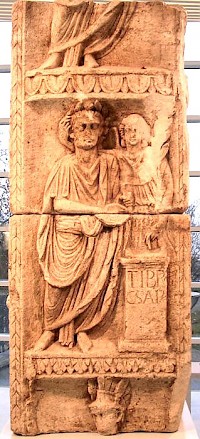Nijmegen, Batavodurum
Q1309708Nijmegen: city in the Netherlands, where several Roman settlements have been discovered.
Origin
When the Romans built the legionary base at the Hunerberg, they started to live in a friendly territory. The local tribe, the Batavians, had been settled there recently, perhaps in 39 BCE, perhaps in 19, the year in which the Hunerberg fortress was built. Whatever the correct year of the arrival of the Batavians, it is certain that the legions needed them: as auxiliaries, as farmers, and as merchants. It comes as no surprise that a civil settlement came into being, west of the Hunerberg settlement. The distance between the western wall of the fortress and the town's eastern gate was less than 500 meter.
Excavations at the St.-Josephhof (in 2005 and 2006) have proved that there were people living on that site in the decade BCE. This street - systematically developped - was at the southern edge of the town, and it is to be expected that excavations in the ancient center, at the Valkhof, will bring objects to light that are a bit older. This might help us establish whether the town was founded in 39 or 19, which in turn helps us understand whether the town owed its existence to the arrival of the legions, or that the legionary base was chosen because there was already a village.
This civil settlement, in our sources sometimes called Batavodurum (Celtic for "marketplace of the Batavians") or Oppidum Batavorum ("hillfort of the Batavians"), was on the hill known as Valkhof and a bit more to the east (map). Several scholars have argued that Batavodurum and Oppidum Batavorum were two towns. However, other cities did have two names, so we probably do not have to accept that there were two Batavian settlements.
Location
The site was well-chosen. The Valkhof and Hunerberg are part of an ice-pushed ridge south of the river Waal, the main distribuary branch of the Rhine. From Gaul, the river Meuse flows to the north, but it cannot break through the ridge, and turns to the west, joining the Waal further downstream. At Nijmegen, only ten kilometer separate the two streams, which means that it is easy to bring food supplies to the Hunerberg; Batavodurum was the logical point for traders to settle.
Although excavations have taken place since 1910, it was not until the 1970s that the archaeologists realized what they had found. This can be explained from the fact that it is very hard to get an overall picture of the ancient settlement, which is situated underneath the very heart of a modern city. Besides, it turned out that Batavodurum was larger than anyone had expected: about a kilometer long, about 300 meter from the Waal to the south, covering at least twenty-five hectare. It may in fact have been larger, because the northern edge - along the river - has been washed away. Traces of the ditch have been found in the west near the medieval Town Hall, in the south near the Marienburg Chapel, and in the east in the Barbarossastraat.
A monumental town
There was another unexpected aspect: the Roman nature of the city. There are indications that from the very start, the town had a gridiron map, which made it look like a Roman town. (A parallel development took place in Tongeren.) The name, and the fact that it was settled with migrating Batavians, had led to the idea that Batavodurum had to have a more native look. One would even doubt whether the excavated settlement is really identical to the town of the Batavians, if the town had not been destroyed by fire in the third quarter of the first century: from the Roman historian Tacitus, we know that this was the ultimate fate of Batavodurum during the Batavian Revolt (70 CE).note

The destroyed town offered little to archaeologists: everything above surface level was destroyed. The only really conspicuous monument that has been found, was a victory monument that was dedicated to the Roman emperor Tiberius. The archaeologists have to reconstruct Batavodurum from the cellars they have excavated. From these unpretentious remains, we learn that the first houses were made of wood, wattle, and daub. After 40 CE, several houses were erected out of stone, which had been imported from the Eifel Mountains. At least one house had a wall covered with a black-and-red fresco; again, there is a parallel to Tongeren.
The streets were covered with pebbles. The Lange Hezelstraat and the Burchtstraat are continuations of the ancient main road, which went from east to west and connected the town to the Hunerberg fortress through the Barbarossastraat. South of the last-mentioned street was the cemetery, along the modern Hugo de Grootstraat and the Museum Kamstraat. There must have been about 4,000 cremation tombs. As the town existed from, say, 10 BCE to 70 CE, and the average life expectancy was about twenty years, we may deduce that there were about 1,000 people living in Batavodurum.
The end
Batavodurum was abandoned after 70; the survivors moved to Noviomagus. The old town was converted into a cemetery: many people were buried along the old main road;. The northwestern part of old Batavodurum remained in use as river port; and in the fourth century, the Valkhof was again in use, now as a castle - which it has remained until 1797.